Businesses in the professional, scientific and technical activities sector
Data extracted in June 2024
Planned article update: June 2025
Highlights
The professional, scientific and technical activity sector employed 11.6 million persons and accounted for 7.4 % of employment in the EU in 2021.
The professional, scientific and technical activity sector generated €681.8 billion of value added in 2021.
This article presents an overview of statistics for the European Union’s (EU) professional, scientific and technical services sector, as covered by NACE Rev. 2 Section M. These activities often require a high degree of education and training and make specialised knowledge and skills available to clients who may be other business users or private individuals. This article belongs to a set of statistical articles on 'Business economy by sector'.
Full article
Structural profile
The EU’s professional, scientific and technical activity sector (NACE Section M) numbered 4.8 million enterprises in 2021, an increase of 6.8 % compared to 2020. The sector employed 11.6 million persons, 3.6 % more compare to the previous year. It has generated €681.8 billion of value added, a growth of 14.5 % compared to 2020. This sector’s contribution to the business economy (Sections B to N and P to R, as well as Divisions S95 and S96) was 15.5 % of the enterprise population, 7.4 % of the employment, and 7.3 % of value added.
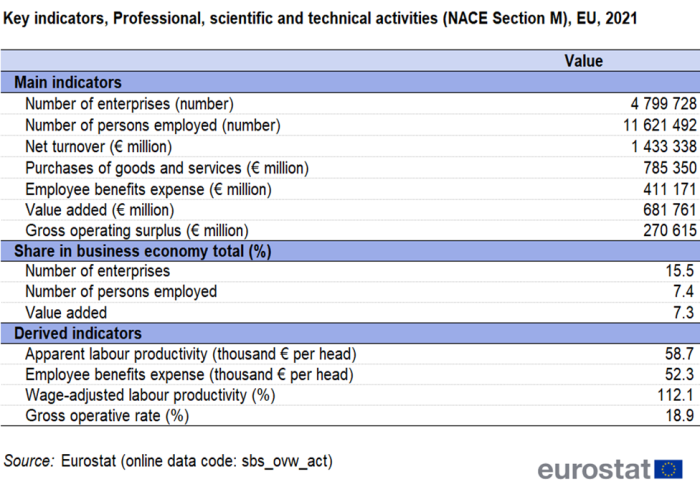
The apparent labour productivity of the EU’s professional, scientific and technical activity sector in 2021 was €58 700 per person employed, which was slightly below the business economy average of €60 200 per person employed. The average employee benefits expense (average personnel costs) within the professional, scientific and technical activity sector were €52 300 per employee, which was above the average for the business economy (€39 000 per employee).
The wage-adjusted labour productivity ratio shows that value added per person employed was equivalent to 112.1 % of average personnel costs per employee across the EU in 2021. This ratio was under the business economy average (154.4 %) and the fourth lowest in the business economy (Sections B to N and P to R, as well as Divisions S95 and S96). The EU’s professional, scientific and technical activity sector recorded a gross operating rate of 18.9 % in 2021, higher than the 13.2 % average for the whole of the business economy.
Sectoral analysis
The professional, scientific and technical activities sector can be divided into seven subsectors at the NACE division level. Among these, according to the data available for 2021, there were big differences in their contribution to value added and employment. Three subsectors, namely legal and accounting activities (Division 69), architectural and engineering activities; technical testing and analysis (Division 71) and activities of head offices; management consultancy activities (Division 70) provided in total almost 75 % of its employment in 2021. The same three subsector recorded also the highest number of enterprises active within the professional, scientific and technical activities sector. Veterinary activities (Division 75) was the smallest subsector in both value added and employment terms, with 1.6 % and 2.2 % respectively, while scientific research and development (Division 72) had the lowest number of enterprises.
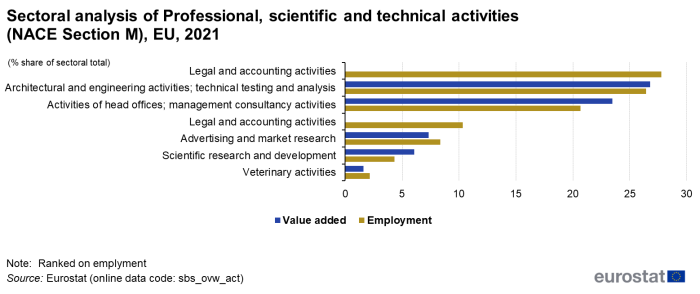
(% share of sectoral total) - Source: Eurostat (sbs_ovw_act)
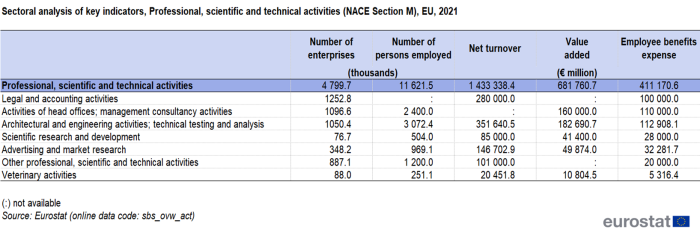
Among the five subsectors for which data are available, the subsector of scientific research and development (Division 72) recorded the highest levels of apparent labour productivity (€82 100 per person employed), followed by activities of head offices; management consultancy activities (Division 70) with €66 700 per person employed. In terms of average employee benefits expense, the same two subsectors recorded the highest levels in the EU across the professional, scientific and technical services sector in 2021, with €62 200 and €64 700 per employee respectively— see Table 2b. Five of the subsectors for which data are available recorded a gross operative rate in 2021 that was equal to or higher than the business economy average (13.2 %). Only advertising and market research (Division 73) recorded a lower rate (12.0 %).

Country overview
The most specialized EU Member States in employment terms in the professional, scientific and technical services sector in 2021 were Cyprus and Luxembourg as each contributed to more than 10 % of their business economy employment in these activities. Luxembourg was also in the top ranking in relation to the most specialized Member States for value added, exceeded only by Malta, each with double-digit shares of at least 10 % in 2021.
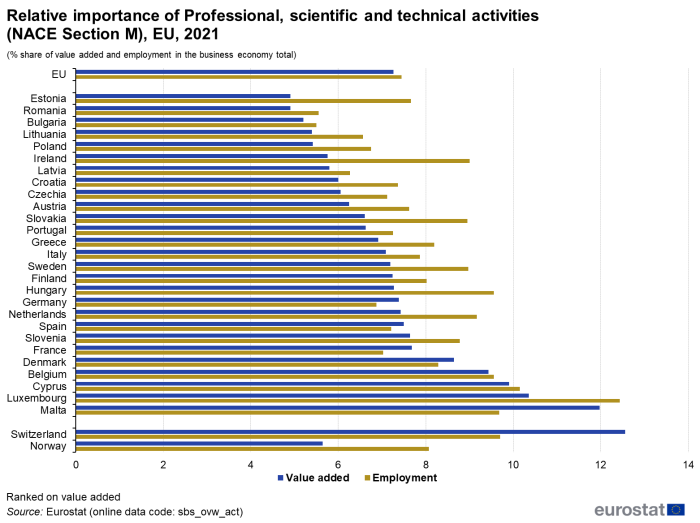
(% share of value added and employment in the business economy total) - Source: Eurostat (sbs_ovw_act)
Germany had the largest share of EU within the professional, scientific and technical services sector in 2021 in both value added (29.8 %) and sectorial employment (22.7 % of the total). The five largest EU Member States generated 71.6 % of the EU’s value added and contributed to almost two thirds (62.4 %) of the EU’s employment which is in line with shares for non-financial economy as whole.

(cumulative share of the five principal Member States as a % of the EU total) - Source: Eurostat (sbs_ovw_act)
More detailed analysis by NACE division, shows that Germany had the highest level of value added among the EU Member States in all seven subsectors.

In absolute terms, Germany generated €203.0 billion of value added in professional, scientific and technical activities in 2021. The ranking was completed by France (€104.3 billion), Italy (€69.9 billion), the Netherlands (€60.4 billion) and Spain (€50.4 billion).
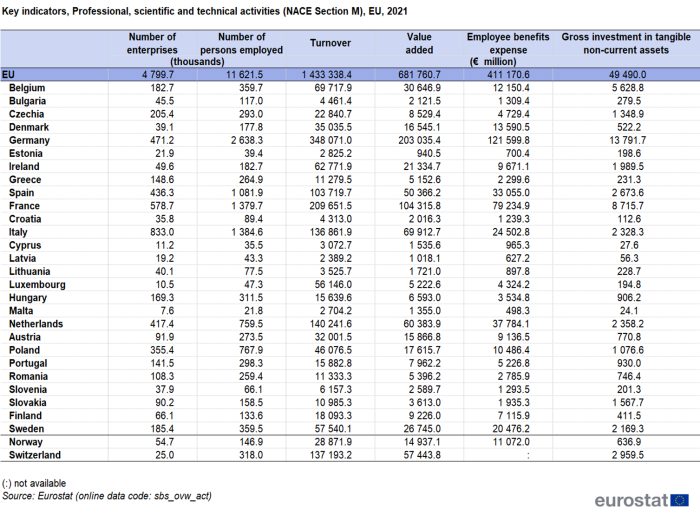
The apparent labour productivity of the professional, scientific and technical services sector in 2021 was less than €20 000 per person employed in Greece and Bulgaria, while it exceeded €80 000 per person employed in Belgium, Sweden, Denmark and Luxembourg, while peaking at €116 800 per person employed in Ireland. It was even higher, at €180 600 per person employed in Switzerland (not an EU Member State).
However, after adjusting for the average employee benefits expense the ranking of countries according to the wage-adjusted labour productivity was a bit different. The highest wage-adjusted labour productivity was recorded in Malta (200.4 %), followed by Ireland (190.0 %), Cyprus (150.7 %) and Romania (149.9 %).
At the other side, Poland, Hungary, Portugal and Czechia had wage-adjusted labour productivity ratios below parity, mainly due to lower apparent labour productivity.
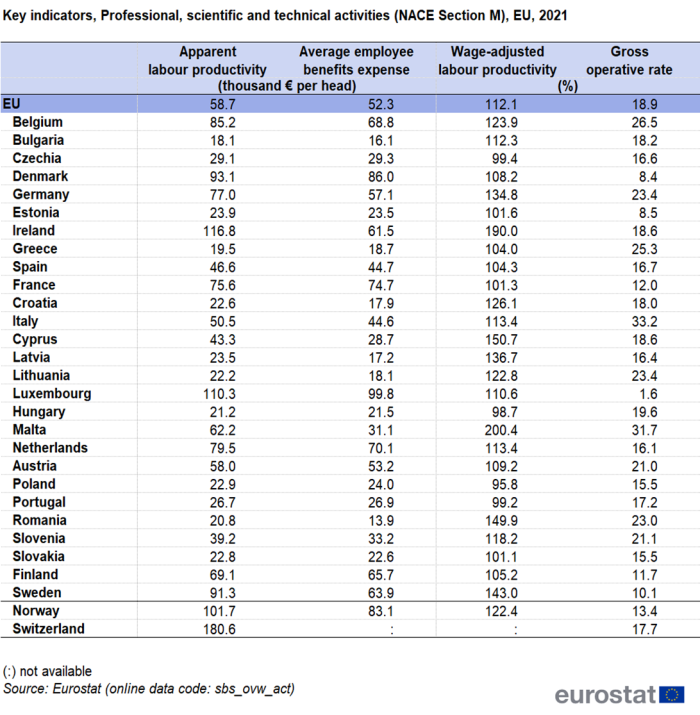
Data sources
Coverage
In NACE the following seven divisions are included as part of this sector:
- legal and accounting activities (Division 69);
- activities of head offices and management consultancy activities (Division 70);
- architectural, engineering and technical consultancy services (Division 71);
- scientific research and development (Division 72);
- advertising (including direct mailing) and market research (Division 73);
- other professional, scientific and technical services such as design, photography, translation and interpretation services (Division 74);
- veterinary services for farm animals and pets (Division 75).
The professional, scientific and technical services sector does not include activities of holding companies that are not engaged in managing (which are classified as a financial activity), while management consultancy does not include educational consultancy activities (which are part of the education sector). Test drilling in connection with mining operations is considered part of the mining and quarrying sector (Section B) rather than technical consultancy.
Data sources
The analysis presented in this article is based on the main dataset for structural business statistics (SBS), size class data and regional data, all of which are published annually.
The main series provides information for each EU Member State as well as a number of non-member countries at a detailed level according to the activity classification NACE. Data are available for a wide range of variables.
In structural business statistics, size classes are generally defined by the number of persons employed. A limited set of the standard structural business statistics variables (for example, the number of enterprises, turnover, persons employed and value added) are analysed by size class, mostly down to the three-digit (group) level of NACE. The main size classes used in this article for presenting the results are:
- small and medium-sized enterprises (SMEs): with 1 to 249 persons employed, further divided into:
- micro enterprises: with less than 10 persons employed;
- small enterprises: with 10 to 49 persons employed;
- medium-sized enterprises: with 50 to 249 persons employed;
- large enterprises: with 250 or more persons employed.
Structural business statistics also include regional data. Regional SBS data are available at NUTS levels 1 and 2 for the EU Member States, Iceland and Norway, mostly down to the two-digit (division) level of NACE. The main variable analyzed in this article is the number of persons employed. The type of statistical unit used for regional SBS data is normally the local unit, which is an enterprise or part of an enterprise situated in a geographically identified place. Local units are classified into sectors (by NACE) normally according to their own main activity, but in some EU Member States the activity code is assigned on the basis of the principal activity of the enterprise to which the local unit belongs. The main SBS data series are presented at national level only, and for this national data the statistical unit is the enterprise. It is possible for the principal activity of a local unit to differ from that of the enterprise to which it belongs. Hence, national SBS data from the main series are not necessarily directly comparable with national aggregates compiled from regional SBS.
Context
Many of the services covered within this article could be performed in-house by enterprises themselves, but purchasing (outsourcing) them from service providers enables them to focus on their core activities, taking advantage of the specialization offered by service providers. As such, an efficient and successful professional, scientific and technical services sector can contribute to the overall competitiveness of an economy.
Some professional and technical services are closely regulated by national governments and professional bodies, with restrictions on the number of entrants into the profession, rates charged and billing arrangements, organisational structure of businesses providing these services, exclusive rights enjoyed by practitioners, and the ability to advertise.
The freedom to provide services and the freedom of establishment are central principles to the internal market for services. They guarantee EU enterprises the freedom to establish themselves in other Member States, and the freedom to provide services on the territory of another Member State. The Directive on services in the internal market (COM(2006) 123) aims to achieve a genuine internal market in services, removing legal and administrative barriers to the development of services activities between Member States. As well as covering many professional, scientific and technical services (with the notable exception of services covered by notaries), the Directive applies to a wide variety of services including industrial and construction activities, as well as distributive trades, accommodation and food services, real estate, administrative and support service activities.
Direct access to
- Recent Eurostat publications on SBS
- Key figures on Europe – 2023 edition – see subchapter on Business
- Eurostat’s Regional Yearbook – see chapter 8. Business
- News Release SBS – 2021 final data
Glossary
ESMS metadata files
- Structural business statistics – SBS metadata file